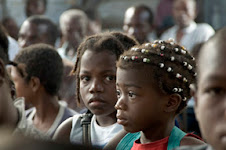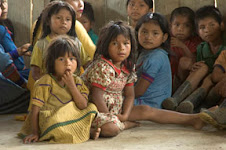Recently, I visited Bellavista, a town I know well, and received a terrible shock.
On May 2, 2002, in the town of Bellavista, municipal capital of Bojayá, El Chocó, there occurred one of the worst massacres in the current armed conflict in Colombia. The town had been taken some time earlier by paramilitary forces, and FARC guerrillas were planning to attack to retake it, as they had recently down nearby.
Anticipating the battle, townspeople took shelter in the church. The paras sought protection behind the church, essentially using the people inside as a human shield. The guerrillas launched a terrible weapon of theirs, a cooking gas tank filled with explosives, at the paras. Tragically, this primitive weapon went off course and fell into the church, killing as many as 119 people and leaving many more wounded both physically and psychically.
Human rights activists blame both sides: the paras for using the people as a human shield, and the guerrillas, for firing despite the presence of that same human shield.
Part of the government response to this tragedy has been the construction of a new town, Nueva Bellavista, a little upriver. Under the best of conditions, this would have been a questionable decision; a strong argument can be made that Bellavista should have been maintained and strengthened as an important historical monument, that they way to support the people who had lived through this tremendous trauma would have been to create programs to launch sustainable economic development projects, develop social supports and otherwise meet the needs of the people.
But even the project for the new town was a bad one; it is precisely the wrong kind of development if we have the residents of Bellavista in mind. But it might be good for some other people…raising the question whether the motive really was to respond to the needs of the people of Bellavista. More on this in a later post.
The people of Bellavista were obliged to leave. Finally, the electricity was cut, and almost everyone left—the only residents now are a small group of Augustine nuns, and it remains to be seen how long they can stay.
Meanwhile, both the former residents and other people have been visiting Bellavista to strip the now-abandoned houses of lumber and other materials. The houses are collapsing as a result, and the place is a ruin. Fine treatment for what should be a monument!
La Vieja Bellavista
Últimamente visité a Bellavista, un pueblo que conozco bien, y recibí un choque...
El 2 de may de 2002, en el pueblo de Bellavista, cabecera municipal de Bojayá, El Chocó, sucedió un de los peores masacres del conflicto armado actual en Colombia. El pueblo se había tomado por las fuerzas paramilitares ha hacía un rato, y la guerrilla de las FARC planeaba un asalto para retomarlo, como habían recién hecho cerca.
En anticipación de la batalla, unos pobladores buscaron abrigo en la iglesia. Los paras se trincharon detrás de la iglesia, prácticamente usando la gente adentro como escudo humano. Los guerrilleros lanzaron un arma terrible suya, una pipeta de gas llena de explosivos, a los paras. Trágicamente, esta arma primitiva se desvió y cayó en la iglesia, matando hasta 119 personas y dejando muchas más heridas tanto física- como sicológicamente.
Trabajadores de derechos humanos echan la culpa a ambos lados: los paras para usar la gente como escudo humano, y los guerrilleros, por tirar a pesar de la presencia de dicha escudo humano.
Parte de la respuesta del gobierno a esta tragedia ha sido la construcción de un pueblo nuevo, Nueva Bellavista, un poco río arriba. En las mejores condiciones, habría sido una decisión dudosa; puede proponerse un argumente fuerte que se debía de mantener y fortalecer a Bellavista como monumento histórico importante, que la manera de apoyar a la gente que había vivido esta trauma tremenda habría sido crear programas para arrancar proyectos de desarrollo económico sostenible, desarrollar programas de apoyo social, y de otras maneras responder a las necesidades de la gente.
Pero hasta el proyecto para el nuevo pueblo era malo; es precisamente un tipo de desarrollo equivocado se tomamos en mente los pobladores de Bellavista. Pero puede servir para otra gente…que nos presenta la pregunta si el motivo de hecho era responder a las necesidades de la gente de Bellavista. Más sobre esto en una entrada por venir.
La gente de Bellavista se vio obligada a salir. Al fin, se les cortó la luz, y salió casi todo el mundo—las únicas residentes ahora son un pequeño grupo de hermanas agustinas, y veremos hasta cuando podrán permanecer allá.
Mientras tanto, tanto los antiguos habitantes como otras personas han visitado a Bellavista para sacar de las ahora abandonadas casas madera y otros materiales. Como resultado, las casa se están cayendo, y el lugar es una ruina. ¡Clase de trato por lo que debe ser monumento!




























